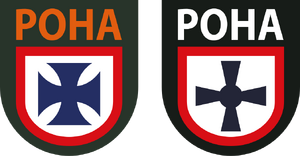The Russian National Liberation Army (Russkaya Osvoboditelnaya Narodnaya Armiya, RONA) was initially formed in 1941, as an auxiliary police unit for the Lokot region near Bryansk. Originally numbering just 200 men, the unit was formed by Bronislav Kaminski and Konstantin Vosobolnik, assisting in reprisals against the civilian population accused of abetting Soviet partisans or loyalty to the regime. After Voskobolnik was killed in a partisan raid in 1942, Kaminski took over command and steadily built up his unit and position in the German empire. His forces were an essential part of Operation Vogelsang in mid-1942, leading to the apex of Kaminski's influence.
The Russian National Liberation Army (Russkaya Osvoboditelnaya Narodnaya Armiya, RONA) came into being in late 1942, bolstered by drafting able-bodied men in the Lokot Autonomy (or rather, Nazi colony). At its peak in 1943, before the catastrophic battle of the Kursk salient, RONA was about the size of a brigade, with some 13 000 men at arms and a small armored force consisting of salvaged Soviet armor. Responsible for rear security during Zitadelle, RONA suffered after the Soviet victory, with its number dwindling due to mounting casualties and desertions, with Kaminski himself narrowly avoiding several attempts on his life.
By 1944, the brigade was in shambles, propped up with reinforcements from police units from occupied Belarus. After several anti-partisan operations under SS-Kampfgruppe von Gottberg, alongside the notorious Oskar Dirlewanger, RONA was absorbed by the Waffen-SS and designated an SS-Sturmbrigade, with Kaminski awarded the rank of Waffen-Brigadefuhrer. Operation Bagration forced the cancellation of anti-partisan operations and RONA was recalled to Neuhammer to be reformed into a Grenadier Division (29. Waffen-Grenadier-Division der SS).
The plans ended due to the Warsaw Uprising. RONA was sent into the city to contain the uprising. Experienced in murdering civilians and fighting partisans in the forest, RONA disgraced itself: Its soldiers suffered high casualties, participated in looting, murdered civilians en masse, and consistently failed to make any headway in the city.
The brigade's death knell came with Kaminski's death. RONA was disbanded and survivors transferred to Vlasov's ROA. After the war, RONA survivors were hunted down and imprisoned or executed by Soviet authorities.
Available elements[ | ]
Divisions[ | ]
- Korück 559: Several RONA units are available.

